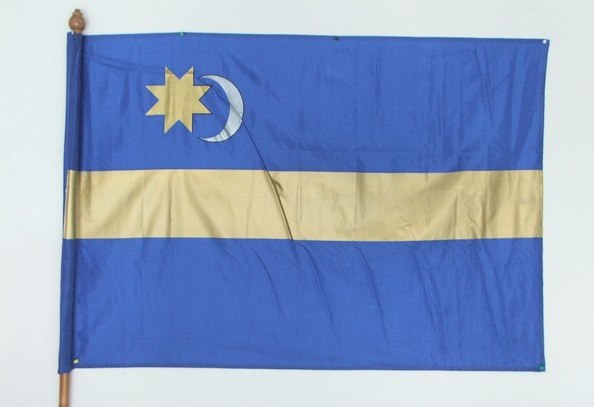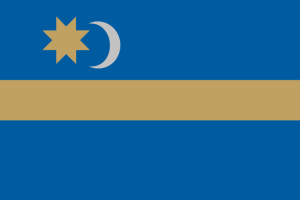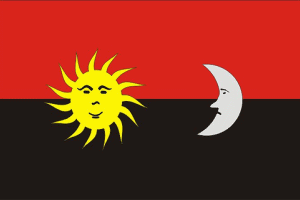![]() 게시 위치 Hungary - 사회적 상호 작용 및 오락 - 02 Nov 2022 09:33 - 0
게시 위치 Hungary - 사회적 상호 작용 및 오락 - 02 Nov 2022 09:33 - 0
Hungary A zászló nem csak bot és vászon, írja Kosztolányi Dezső. A zászló „mindig beszél… Mindig önkívületben van az utca fölött, föllengő magasan, egész az égben, s hirdet valamit rajongva.” Hirdeti egy közösség összetartozását – sok ember egy nemzethez tartozását. Mivel a székelyek a magyar zászlót nem használhatják nyilvánosan, saját zászlót alkottak meg, ezzel is erősítve autonómiatörekvéseiket.
 A Székely Nemzeti Tanács 2004. január 17-én döntött saját jelképeinek elfogadásáról. A Sepsiszentgyörgyön tartott ülésen a testület jelvényének az égszínkék pajzsot nyilvánították, rajta ezüst félholddal és arany nyolcágú csillaggal. Zászlója az égszínkék, középen arany sávval hasított lobogó lett, melyen a címerhez hasonlóan az ősi motívumok láthatóak. Mindkettő Kónya Ádám művelődéstörténész munkája, aki hosszas kutatások eredményeként, ősi történelmi szimbólumokat felhasználva alkotta meg a székely nép ma használatos jelképeit, amelyeket 2009. szeptember 5-én nyilvánított Székelyföld zászlajának és címerének a Székelyföldi Önkormányzati Nagygyűlés. A kék-arany lobogó 2009 novembere óta Hargita megye hivatalos zászlója is.A zászló és a címer elkészítésében számos forrás segítette Kónya Ádámot. Többek között Mika Sándor történész Erdélyi hadi zászlók 1601-ből című tanulmánya, mely 1893-ban jelent meg. Mika egy különleges forrást tár az olvasók elé, melyre történésztársa, Szilágyi Sándor bukkant 1892-ben Drezdában. A kézirat az 1601. augusztus 3-i goroszlói csata emlékére készült, ahol a Báthori Zsigmond megsemmisítő vereséget szenvedett Giorgio Basta és Mihály havasalföldi vajda seregétől. A császáriak az egyéb más hadizsákmány mellett 110 erdélyi zászlót is megszereztek, melyeket fényes külsőségek között mutattak be Prágában Rudolf császárnak. Az ünnepségen jelen volt Puchner György, a szász választófejedelem egy tisztje, aki ura számára megörökítette a zsákmányolt zászlókat a Szilágyi által felfedezett kéziratban. Mika Sándor, aki 1893-ban e kutatási eredményeket felhasználva tanulmányt írt a Turulba, említést tett egy másik Drezdában talált kódexről is, amely 190 török és magyar zászlót örökített meg. Mika ezt a kódexet is Puchnernek tulajdonította, és valószínűsítette, hogy az ebben megfestett török zászlók Győr bevételekor, az erdélyi zászlók pedig a scenbergi és a brói csatákkor kerültek a császáriak kezére.
A Székely Nemzeti Tanács 2004. január 17-én döntött saját jelképeinek elfogadásáról. A Sepsiszentgyörgyön tartott ülésen a testület jelvényének az égszínkék pajzsot nyilvánították, rajta ezüst félholddal és arany nyolcágú csillaggal. Zászlója az égszínkék, középen arany sávval hasított lobogó lett, melyen a címerhez hasonlóan az ősi motívumok láthatóak. Mindkettő Kónya Ádám művelődéstörténész munkája, aki hosszas kutatások eredményeként, ősi történelmi szimbólumokat felhasználva alkotta meg a székely nép ma használatos jelképeit, amelyeket 2009. szeptember 5-én nyilvánított Székelyföld zászlajának és címerének a Székelyföldi Önkormányzati Nagygyűlés. A kék-arany lobogó 2009 novembere óta Hargita megye hivatalos zászlója is.A zászló és a címer elkészítésében számos forrás segítette Kónya Ádámot. Többek között Mika Sándor történész Erdélyi hadi zászlók 1601-ből című tanulmánya, mely 1893-ban jelent meg. Mika egy különleges forrást tár az olvasók elé, melyre történésztársa, Szilágyi Sándor bukkant 1892-ben Drezdában. A kézirat az 1601. augusztus 3-i goroszlói csata emlékére készült, ahol a Báthori Zsigmond megsemmisítő vereséget szenvedett Giorgio Basta és Mihály havasalföldi vajda seregétől. A császáriak az egyéb más hadizsákmány mellett 110 erdélyi zászlót is megszereztek, melyeket fényes külsőségek között mutattak be Prágában Rudolf császárnak. Az ünnepségen jelen volt Puchner György, a szász választófejedelem egy tisztje, aki ura számára megörökítette a zsákmányolt zászlókat a Szilágyi által felfedezett kéziratban. Mika Sándor, aki 1893-ban e kutatási eredményeket felhasználva tanulmányt írt a Turulba, említést tett egy másik Drezdában talált kódexről is, amely 190 török és magyar zászlót örökített meg. Mika ezt a kódexet is Puchnernek tulajdonította, és valószínűsítette, hogy az ebben megfestett török zászlók Győr bevételekor, az erdélyi zászlók pedig a scenbergi és a brói csatákkor kerültek a császáriak kezére. a kék-arany székely zászlóAz 1601-ben elkobzott zászlókat Báthory Zsigmond erdélyi fejedelem adományozta hadainak, miután a Basta által egyesített sereg ellen fegyverbe szólította őket. A Kolozsvár közelében lévő Szamosfalva mellett gyülekeztek, ahol hadseregének csapatait 43 új, rendkívül díszes zászlóval ajándékozta meg. A legszebbeket Csáky István és Székely Mózes kapták, akiket a sereg főkapitányává nevezett ki. Székely Mózes zászlója szolgált mintául a ma használatos arany-kék lobogónak, melynek kék alapszínén fehér sáv fut, benne Z. M. monogrammal. A mai arany sáv vélhetően az Erdélyi Fejedelemség régi zászlójára utal, melyről csak annyi feljegyzés maradt, hogy aranyos színű volt, de más források is arról tudósítanak, hogy Erdély színei a kék és az arany voltak. A hold és a csillag, amely a mai zászlót díszíti, Kónya Ádám kutatásai szerint a székelység legősibb jelvényei, számos régi pecsétnyomón találkozhatunk velük, sőt, Székely Mózes címerén is feltűnik a növekvő hold és a nyolcágú csillag. A Puchner által megfestett zászlók közül többön is előfordul ez a motívum, például Csíkszékén. „Lilaszín zászló, s rajta lévő kép a keresztre feszített Jézus Krisztust ábrázolja, a kereszt lábánál jobbról Mária, balján János apostol alakjával. A zászlón látható hold és csillag székely eredetre vallanak, s aligha csalódunk, ha e zászlóban az egyetlen tisztán katolikus székely szék, Csíkszék zászlóját véljük felismerni” – írta Mika Sándor.
a kék-arany székely zászlóAz 1601-ben elkobzott zászlókat Báthory Zsigmond erdélyi fejedelem adományozta hadainak, miután a Basta által egyesített sereg ellen fegyverbe szólította őket. A Kolozsvár közelében lévő Szamosfalva mellett gyülekeztek, ahol hadseregének csapatait 43 új, rendkívül díszes zászlóval ajándékozta meg. A legszebbeket Csáky István és Székely Mózes kapták, akiket a sereg főkapitányává nevezett ki. Székely Mózes zászlója szolgált mintául a ma használatos arany-kék lobogónak, melynek kék alapszínén fehér sáv fut, benne Z. M. monogrammal. A mai arany sáv vélhetően az Erdélyi Fejedelemség régi zászlójára utal, melyről csak annyi feljegyzés maradt, hogy aranyos színű volt, de más források is arról tudósítanak, hogy Erdély színei a kék és az arany voltak. A hold és a csillag, amely a mai zászlót díszíti, Kónya Ádám kutatásai szerint a székelység legősibb jelvényei, számos régi pecsétnyomón találkozhatunk velük, sőt, Székely Mózes címerén is feltűnik a növekvő hold és a nyolcágú csillag. A Puchner által megfestett zászlók közül többön is előfordul ez a motívum, például Csíkszékén. „Lilaszín zászló, s rajta lévő kép a keresztre feszített Jézus Krisztust ábrázolja, a kereszt lábánál jobbról Mária, balján János apostol alakjával. A zászlón látható hold és csillag székely eredetre vallanak, s aligha csalódunk, ha e zászlóban az egyetlen tisztán katolikus székely szék, Csíkszék zászlóját véljük felismerni” – írta Mika Sándor. a vörös-fekete székely zászlóA köztudatban elterjedt vörös-fekete székely zászlót Kónya Ádám egy interjúban bizonytalan eredetűnek nevezte, mivel 1968 előttről semmilyen forrást nem talált, hogy az korábban is használatban lett volna. Kónya szerint amikor a megyésítés után meg kellett alkotni a megyék címereit, akkor a Hargita megyei illetékes intézménynél úgy gondolhatták, hogy a helyi hagyományokra utaló jelként be lehetne vinni a vörös-fekete színkombinációt Hargita megye címerébe, utalva ezzel a székely női népviselet alapszíneire. A későbbiekben aztán ezt azonosították a hagyományos székely zászlóval.
a vörös-fekete székely zászlóA köztudatban elterjedt vörös-fekete székely zászlót Kónya Ádám egy interjúban bizonytalan eredetűnek nevezte, mivel 1968 előttről semmilyen forrást nem talált, hogy az korábban is használatban lett volna. Kónya szerint amikor a megyésítés után meg kellett alkotni a megyék címereit, akkor a Hargita megyei illetékes intézménynél úgy gondolhatták, hogy a helyi hagyományokra utaló jelként be lehetne vinni a vörös-fekete színkombinációt Hargita megye címerébe, utalva ezzel a székely női népviselet alapszíneire. A későbbiekben aztán ezt azonosították a hagyományos székely zászlóval.English
The flag is not just a stick and canvas, writes Dezső Kosztolányi. The flag "always speaks... It is always in a frenzy above the street, flying high, high in the sky, proclaiming something with enthusiasm." It proclaims the unity of a community - the belonging of many people to a nation. Since the Szeklers are not allowed to use the Hungarian flag in public, they have created their own flag, thus strengthening their aspirations for autonomy.
On 17 January 2004, the Szekler National Council decided to adopt its own symbols. At a meeting held in Sfântu Gheorghe, the emblem of the body was declared to be a sky-blue shield with a silver crescent and a gold eight-pointed star. The flag is the sky blue flag with a gold stripe down the middle, showing the ancient motifs of the coat of arms. Both are the work of Ádám Kónya, a cultural historian who, as a result of extensive research and using ancient historical symbols, created the symbols of the Szekler people used today, which were declared the flag and coat of arms of Szeklerland by the Grand Assembly of the Szeklerland Self-Government on 5 September 2009. Since November 2009, the blue and gold flag has also been the official flag of Harghita County.
The flag and the coat of arms were created with the help of many sources. Among them is the study by the historian Sándor Mika, entitled Transylvanian Military Flags from 1601, published in 1893. Mika presents a unique source, discovered by his fellow historian Sándor Szilágyi in Dresden in 1892. The manuscript commemorates the Battle of Goroszlo on 3 August 1601, where Sigismund Báthori suffered a crushing defeat at the hands of the army of Giorgio Basta and Mihály, the Viceroy of the Wallachian Lowlands. In addition to other spoils of war, the imperialists also acquired 110 Transylvanian flags, which were presented to Emperor Rudolf in Prague in splendid state. Present at the ceremony was György Puchner, an officer of the Saxon Electoral Prince, who had recorded the captured flags for his master in a manuscript discovered by Szilágyi. Sándor Mika, who in 1893 wrote a paper in Turul based on the results of this research, also mentioned another codex found in Dresden, which preserved 190 Turkish and Hungarian flags. Mika also attributed this codex to Puchner, and suggested that the Turkish flags painted in it were captured by the imperialists at the time of the fall of Győr, and the Transylvanian flags at the battles of Scenberg and Brasov.
the blue-gold Szekler flag
Confiscated in 1601, the flags were donated by the Transylvanian Prince Báthory Zsigmond to his troops after he had called them to arms against the army united by Basta. They embled near Szamosfalva near Cluj Napoca, where he presented his army troops with 43 new, highly decorated flags. The most beautiful ones were given to István Csáky and Moses Székely, who were appointed captains-in-chief of the army. Mózes Székely's flag was the model for the gold and blue flag in use today, with a white band on a blue background, including Z. M. monogram. The present gold stripe is probably a reference to the old flag of the Principality of Transylvania, which is only recorded as having been gold, but other sources also report that the colours of Transylvania were blue and gold. The moon and the star that adorn the present flag are, according to Ádám Kónya's research, the most ancient symbols of the Szekler nation, and can be found on many old seal stamps, even on the coat of arms of Moses Székely, where the waxing moon and the eight-pointed star appear. This motif also appears on several of the flags painted by Puchner, for example on the flag of Csíkszék. "A purple flag with a picture of Jesus Christ crucified, with the figure of Mary at the foot of the cross on the right and the Apostle John on the left. The moon and star on the flag are of Szekler origin, and we are hardly disappointed if we think that this flag is the flag of the only purely Catholic Szekler seat, Csíkszék", wrote Sándor Mika.
the red and black Szekler flag
In an interview, Ádám Kónya described the red and black Szekler flag, which is in the public domain, as of uncertain origin, as he could not find any source before 1968 that it had been in use before. According to Kónya, when the coat of arms of the counties had to be created after the county was created, the competent institution in Harghita County thought that the red and black colour combination could be introduced into the coat of arms of Harghita County as a symbol of local traditions, referring to the basic colours of the Szekler women's folk costume. This was later identified with the traditional Szekler flag.
후원
MiroMiro댓글 (0)


